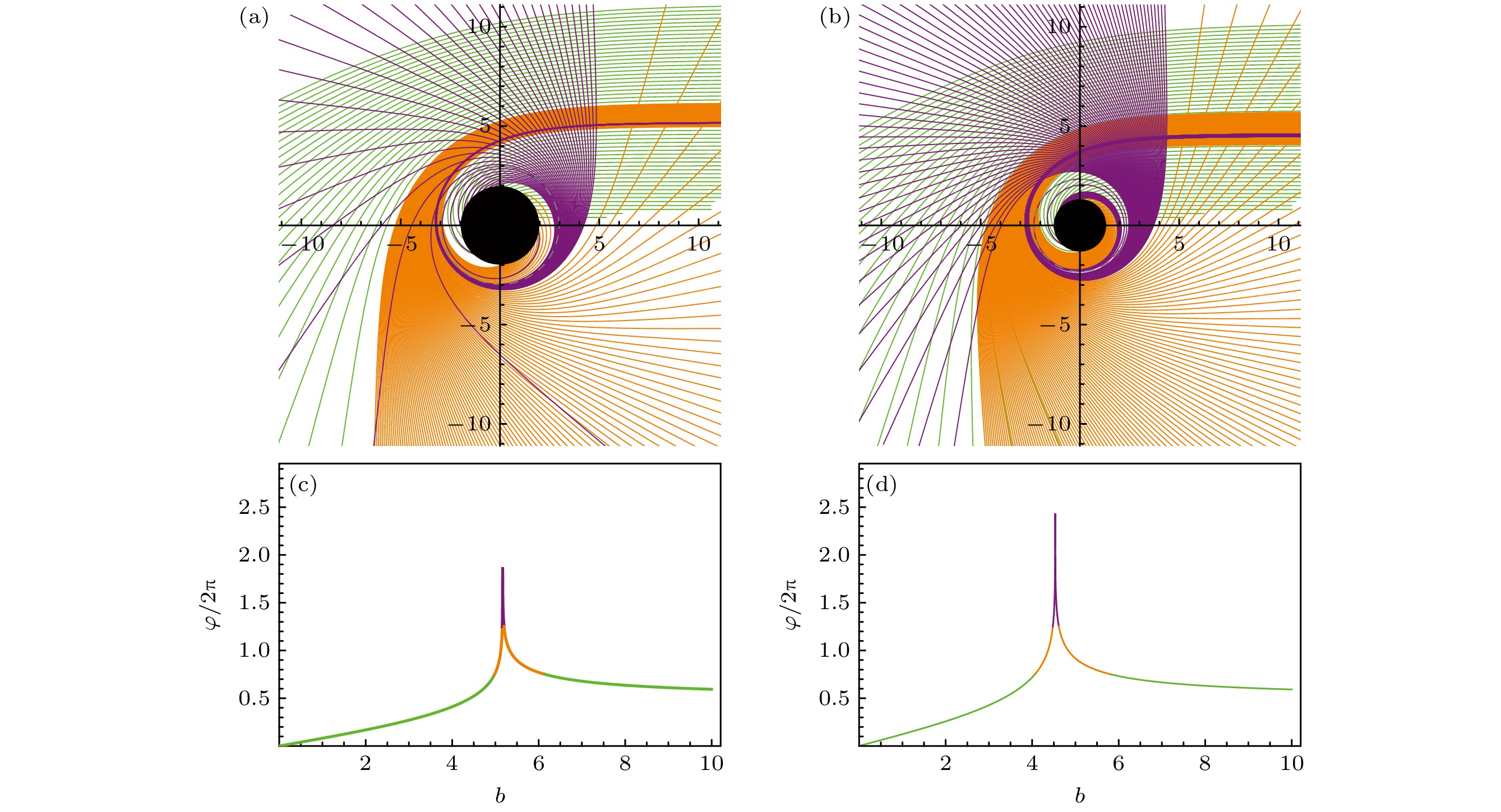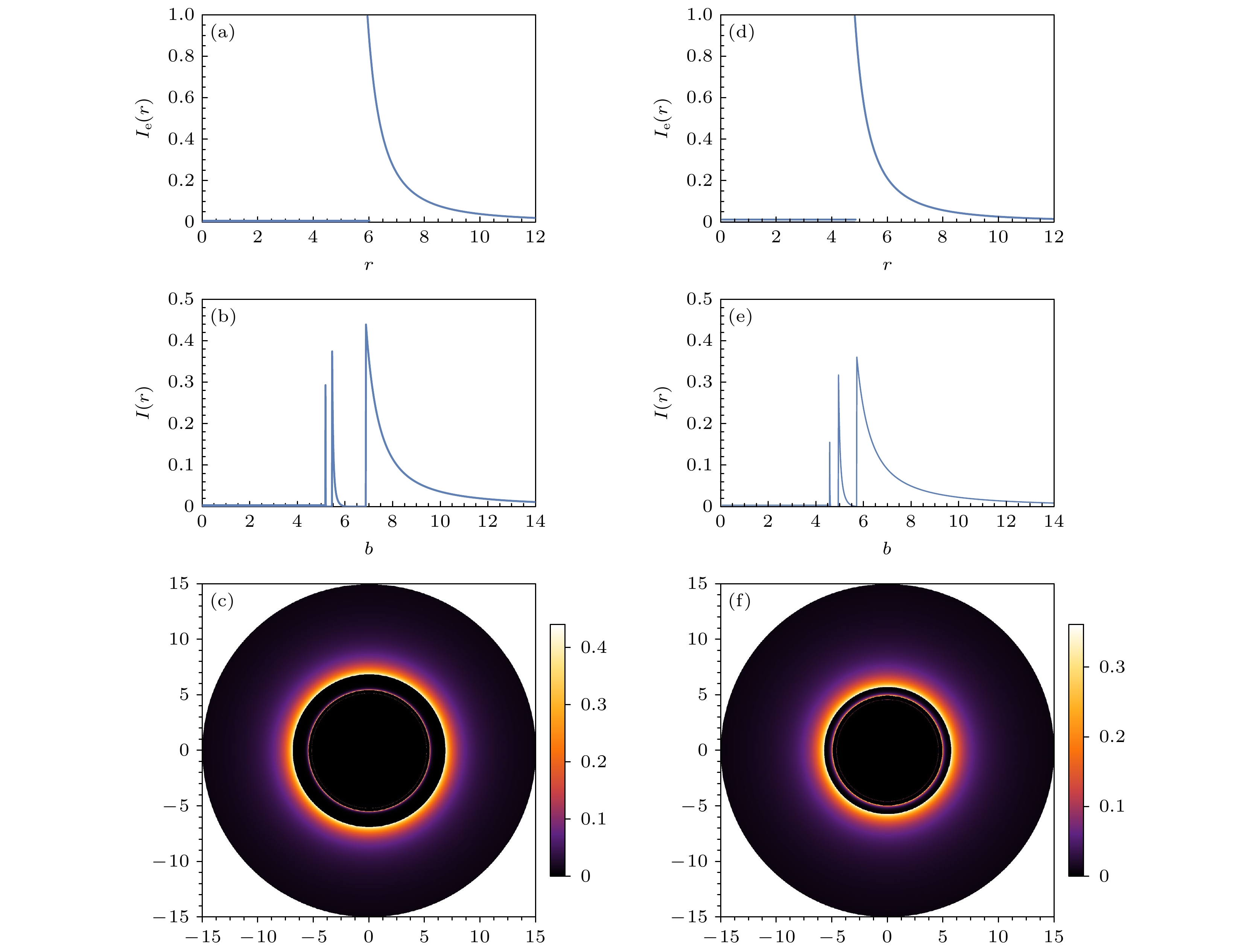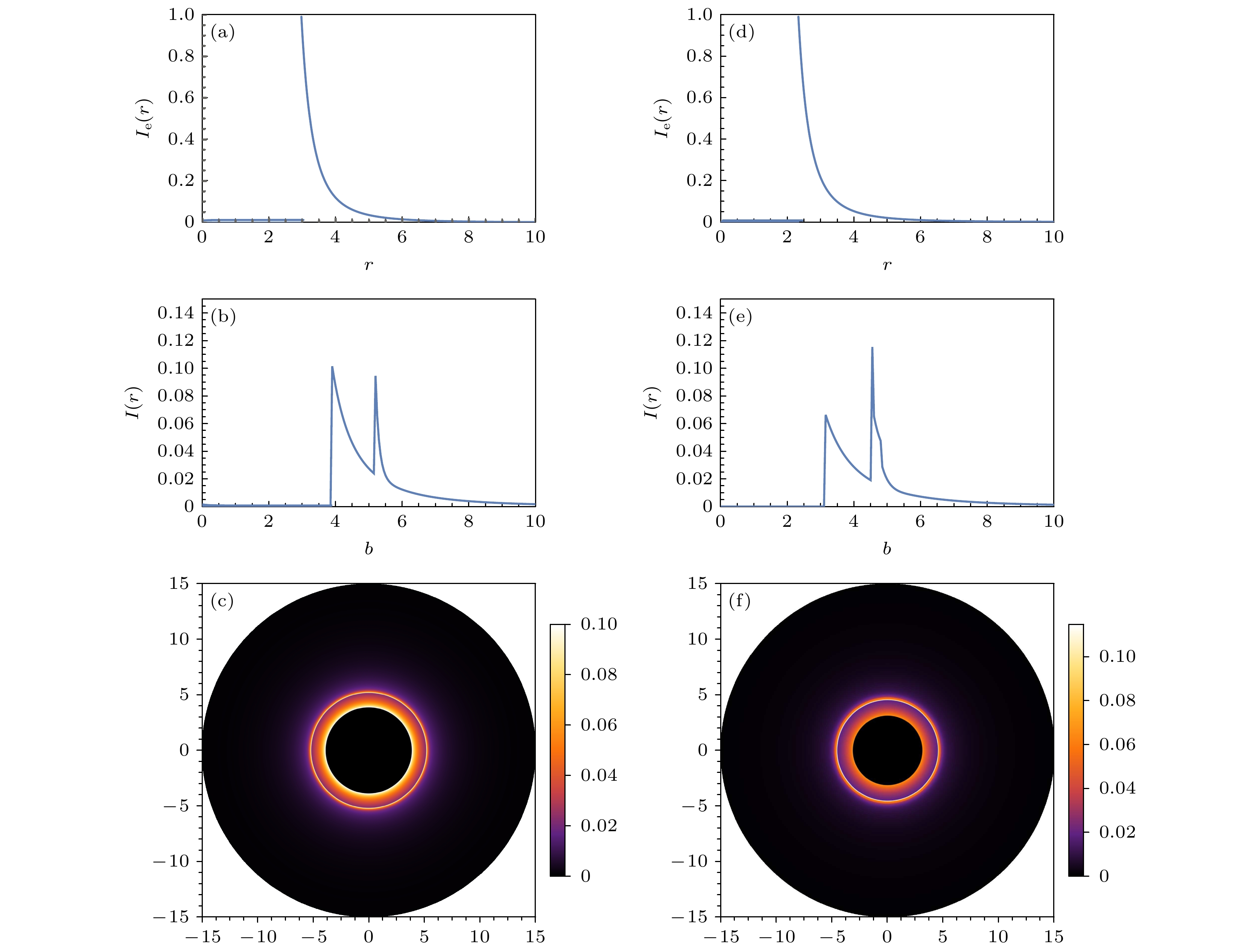-
重点讨论了薄盘吸积与渐近安全 (asymptotically safe, AS)引力修正参数对黑洞阴影和光环的影响. 对于薄盘吸积, 黑洞的暗区就是黑洞的阴影, 而明亮的光环则是由直接像、透镜环和光子环组成的. 对于吸积盘辐射源比强度, 考虑了3个不同辐射轮廓模型. 对辐射起始于最内圆轨道的二阶衰减函数模型, 直接像、透镜环和光子环可以明显区分. 直接像对黑洞光环亮度贡献最大, 透镜环对光环亮度贡献很小, 而光子环的贡献几乎可以忽略, 且对应观测强度的峰值随AS引力参数的增加而减小, 即对应光环亮度随修正参数的增大而变暗. 对于辐射起始于光子球半径的三阶衰减函数模型, 透镜环和光子环叠加在直接像上, 使观测强度出现新的极值. 这一极值随AS引力修正参数的增加而增加, 且使得黑洞光环的亮度更亮. 对辐射起始于事件视界的反三角衰减函数模型, 透镜环和光子环在直接像上的叠加范围更大, 观测到的光环更宽, 且AS引力参数值越小, 透镜环和光子环越难区分, 黑洞光环的亮度越大. 总之, 研究表明, 黑洞阴影半径的大小随AS修正参数的增加而减小, 对于不同的AS引力修正参数, 辐射源光强度、尤其是观测强度的辐射轮廓存在显著差异, 导致黑洞的阴影和亮环明显不同.In this paper, we discuss the influence of thin disk accretion and asymptotically safe (AS) gravity correction parameters on the shadow and photon ring of black hole. For the thin disk accretion, the dark region is the shadow of the black hole, and the bright photon ring is composed of direct image, lensing ring, and photon ring. For the specific intensity of the radiation source of the accretion disk, we consider three different emission profile models. For the second-order attenuation function model in which the emission starts from the innermost circular orbit, direct image, lensing ring, and photon ring can be clearly distinguished. The direct image contributes most of the brightness, and the lensing ring contributes a small portion, while the contribution of the photon ring can almost be ignored. And the observed corresponding intensity peak decreases with the increase of the AS gravity parameter, that is, the corresponding brightness of the photon ring darkens as correction parameter increases. For the third-order attenuation function model in which the emission begins at the radius of the photon sphere, lensing ring and photon ring are superimposed on the direct radiation. Thus a new extreme value of the observed intensity emerges, and the extreme value increases with the increase of the AS gravity parameter, which leads to a brighter observed photon ring. For the anti-trigonometric attenuation function model in which the radiation starts from the event horizon, the superposition range of lensing ring and photon ring on the direct radiation becomes larger, which makes photon ring wider. The smaller the AS gravity parameter, the more difficult it is to distinguish between the lensing ring and photon ring, and the brighter the photon ring turns. In short, the results show that the shadow radius decreases with the increase of the AS correction parameter. For different AS gravity correction parameters, the light intensities of emission source, especially emission profiles of the observed intensity are significantly different, resulting in obvious differences in observed emission intensity between the shadow of the black hole and the bright photon ring of the black hole.
-
Keywords:
- black hole shadow /
- photon ring /
- lensing rings /
- asymptotically safe gravity
[1] Akiyama K, Alberdi A, Alef W, et al. 2019 Astrophys. J. 875 L1
 Google Scholar
Google Scholar
[2] Luminet J P 1979 Astron. Astrophys. 75 228
[3] Bardeen J M 1973 Black Holes (New York: Gordon and Breach) pp215–239
[4] Darwin C G 1959 Proc. R. Soc. London, Ser. A 249 180
 Google Scholar
Google Scholar
[5] Gan Q, Wang P, Wu H, et al. 2021 Phys. Rev. D 104 044049
 Google Scholar
Google Scholar
[6] Gralla S E, Lupsasca A, Marrone D P 2020 Phys. Rev. D 102 124004
 Google Scholar
Google Scholar
[7] Himwich E, Johnson M D, Lupsasca A, et al. 2020 Phys. Rev. D 101 084020
 Google Scholar
Google Scholar
[8] Guo M, Zhong Z, Wang J, et al. 2022 Phys. Rev. D 105 024049
 Google Scholar
Google Scholar
[9] Gralla S E, Holz D E, Wald R M 2019 Phys. Rev. D 100 024018
 Google Scholar
Google Scholar
[10] Perlick V, Tsupko O Y, Bisnovatyi-Kogan G S 2015 Phys. Rev. D 92 104031
 Google Scholar
Google Scholar
[11] Chael A, Johson M D, Lupsasca A 2021 Astrophys. J. 918 6
 Google Scholar
Google Scholar
[12] Hou Y, Zhang Z, Yan H, Guo M, Chen B 2022 Phys. Rev. D 106 064058
 Google Scholar
Google Scholar
[13] Zeng X X, Zhang H Q 2020 Eur. Phys. J. C 80 1058
 Google Scholar
Google Scholar
[14] Zeng X X, He K J, Li G P 2022 Sci. China-Phys. Mech. Astron. 65 290411
 Google Scholar
Google Scholar
[15] Cunha P V P, Eiro N A, Herdeiro C A R, Lemos J P S 2020 JCAP 03 035
[16] Li P C, Guo M, Chen B 2020 Phys. Rev. D 101 084041
 Google Scholar
Google Scholar
[17] Zeng X X, Zhang H Q, Zhang H 2020 Eur. Phys. J. C 80 1
 Google Scholar
Google Scholar
[18] He K J, Guo S, Tan S C, et al. 2022 Chin. Phys. C 46 085106
 Google Scholar
Google Scholar
[19] Zeng X X, Li G P, He K J 2022 Nucl. Phys. B 974 115639
 Google Scholar
Google Scholar
[20] Li G P, He K J 2021 Eur. Phys. J. C 81 1018
 Google Scholar
Google Scholar
[21] 高思杰, 郭敏勇, 马永革等 2022 中国科学 52 270002
Gao S J, Guo M Y, Ma Y G, et al. 2022 Sci. China-Phy Mech. Astron. 52 270002
[22] 袁业飞, 唐泽源 2019 科学通报 64 2072
Yuan Y F, Tang Z Y 2019 Sci. Bull. 64 2072
[23] 吴学兵 2019 科学通报 64 2082
Wu X B 2019 Sci. Bull. 64 2082
[24] Chakhchi L, El Moumni H, Masmar K 2022 Phys. Rev. D 105 064031
 Google Scholar
Google Scholar
[25] Broderick A E, Tiede P, Pesce D W, et al. 2022 The Astrophys. J. 927 6
 Google Scholar
Google Scholar
[26] Broderick A E, Pesce D W, Gold R, et al. 2022 Astrophys. J. 935 61
 Google Scholar
Google Scholar
[27] Guo Y, Miao Y G 2022 Nucl. Phys. B 983 115938
 Google Scholar
Google Scholar
[28] Palumbo D C M, Wong G N 2022 Astrophys. J. 929 49
 Google Scholar
Google Scholar
[29] Ashtekar A 1986 Phys. Rev. Lett. 57 2244
 Google Scholar
Google Scholar
[30] Ashtekar A 1987 Phys. Rev. D 36 1587
 Google Scholar
Google Scholar
[31] Ashtekar A, Baez J, Corichi A, et al. 1998 Phys. Rev. Lett. 80 904
 Google Scholar
Google Scholar
[32] Perez A 2003 Classical Quantum Gravity 20 R43
 Google Scholar
Google Scholar
[33] Green M B, Schwarz J H 1984 Phys. Lett. B 149 117
 Google Scholar
Google Scholar
[34] Candelas P, Horowitz G T, Strominger A, et al. 1985 Nucl. Phys. B 258 46
 Google Scholar
Google Scholar
[35] Weinberg S 1979 In General Relativity: An Einstein Centenary Survey (Cambridge: Cambridge University Press) pp790–831
[36] Bonanno A, Reuter M 1999 Phys. Rev. D 60 084011
[37] Ma M S 2014 Phys. Lett. B 735 45
 Google Scholar
Google Scholar
[38] Yang R 2015 Phys. Rev. D 92 084011
 Google Scholar
Google Scholar
[39] Cai Y F, Easson D A 2010 JCAP 09 002
[40] Zuluaga F H, Sánchez L A 2021 Eur. Phys. J. C 81 1
 Google Scholar
Google Scholar
[41] Bambi C 2013 Phys. Rev. D 87 107501
 Google Scholar
Google Scholar
-
图 1 在AS引力下的黑洞的有效势图像, 区域1对应$U(r) < 1/b_{\mathrm{p}}^2$, 区域2对应$U(r) = 1/b_{\mathrm{p}}^2$, 区域3对应$U(r) > 1/b_{\mathrm{p}}^2$: (a) ξ = 0.05, (b) ξ = 0.9
Fig. 1. In the effective potential image of the black hole under AS gravity, region 1 corresponds to $U(r) < 1/b_{\mathrm{p}}^2$, region 2 corresponds to $U(r) = 1/b_{\mathrm{p}}^2$, and region 3 corresponds to $U(r) > 1/b_{\mathrm{p}}^2$: (a) ξ = 0.05, (b) ξ = 0.9.
图 2 极坐标($r, \varphi $)下和光轨迹图像. 蓝线代表$b = {b_{{\mathrm{p}}}}$, 灰线代表$b < {b_{{\mathrm{p}}}}$, 橙色线代表$b > {b_{{\mathrm{p}}}}$. 所有光线的入射参数的间距为0.2, 黑洞用黑色实心圆盘表示 (a) ξ = 0.05; (b) ξ = 0.9
Fig. 2. Tracks of light ray in polar coordinates $(r, \varphi )$. Blue line represents $b = {b_{{\mathrm{p}}}}$, gray line represents $b < {b_{{\mathrm{p}}}}$, and orange line represents $b > {b_{{\mathrm{p}}}}$. The impact parameters for all rays have a spacing of 0.2, black holes are represented by black disks: (a) ξ = 0.05; (b) ξ = 0.9.
图 3 (a), (b)极坐标$(r, \varphi )$下光的运动轨迹; (c), (d) $n = \varphi /2\pi$与b之间的关系. 对于直接像(绿色)、透镜环(橘色)和光子环(紫色)对应的光线, 入射参数的间距分别为$1/5$, $1/100$, $1/1000$. 黑色的圆盘代表黑洞 (a), (c) ξ = 0.05; (b), (d) ξ = 0.9
Fig. 3. (a), (b) Trajectory of light in the polar coordinate $ (r, \varphi) $; (c), (d) relationship between $n = \varphi / 2\pi$ and b. For the direct radiation (green), lensing ring (orange) and photon ring (purple), the spacing of the collision parameters is $1 / 5$, $1 / 100$ and $1 / 1000$ respectively. Black disks represent black holes: (a), (c) ξ = 0.05; (b), (d) ξ = 0.9.
图 6 模型2下的吸积物质比辐射强度轮廓(a), (d), 观察者的观测强度轮廓(b), (e)以及黑洞图像(c), (f) (a)—(c)$\xi=0.05$; (d)—(f) $\xi=0.9$
Fig. 6. Under model 2, the specific intensity profile of accretion disk (a), (d), the observed intensity profile (b), (e), as well as the black hole image (c), (f): (a)–(c) $\xi=0.05$; (d)–(f) $\xi=0.9$.
图 7 模型3下辐射源吸积盘比辐射强度轮廓(a), (d), 观察者的观测强度轮廓(b), (e)以及黑洞图像(c), (f) (a)—(c) $\xi=0.05$; (d)—(f) $\xi=0.9$
Fig. 7. Under the model 3, the specific intensity profile of accretion disk (a), (d), the observed intensity profile (b), (e), as well as the black hole image (c), (f): (a)–(c) $\xi=0.05$; (d)–(f) $\xi=0.9$.
表 1 不同ξ下事件视界${r_ + }$、光子球半径${r_{{\mathrm{p}}}}$和光子球处入射参数${b_{{\mathrm{p}}}}$
Table 1. Event horizon ${r_ + }$, photon sphere radius ${r_{{\mathrm{p}}}}$, and incident parameters at the photon sphere ${b_{{\mathrm{p}}}}$ for different ξ.
$\xi = 0.01$ $\xi = 0.05$ $\xi = 0.1$ $\xi = 0.3$ $\xi = 0.6$ $\xi = 0.9$ ${r_ + }$ 1.99499 1.97468 1.94868 1.83666 1.63246 1.31623 ${r_{{\mathrm{p}}}}$ 2.99443 2.97192 2.9432 2.821 2.60777 2.32892 ${b_{{\mathrm{p}}}}$ 5.19037 5.16701 5.13731 5.0121 4.79933 4.53738 -
[1] Akiyama K, Alberdi A, Alef W, et al. 2019 Astrophys. J. 875 L1
 Google Scholar
Google Scholar
[2] Luminet J P 1979 Astron. Astrophys. 75 228
[3] Bardeen J M 1973 Black Holes (New York: Gordon and Breach) pp215–239
[4] Darwin C G 1959 Proc. R. Soc. London, Ser. A 249 180
 Google Scholar
Google Scholar
[5] Gan Q, Wang P, Wu H, et al. 2021 Phys. Rev. D 104 044049
 Google Scholar
Google Scholar
[6] Gralla S E, Lupsasca A, Marrone D P 2020 Phys. Rev. D 102 124004
 Google Scholar
Google Scholar
[7] Himwich E, Johnson M D, Lupsasca A, et al. 2020 Phys. Rev. D 101 084020
 Google Scholar
Google Scholar
[8] Guo M, Zhong Z, Wang J, et al. 2022 Phys. Rev. D 105 024049
 Google Scholar
Google Scholar
[9] Gralla S E, Holz D E, Wald R M 2019 Phys. Rev. D 100 024018
 Google Scholar
Google Scholar
[10] Perlick V, Tsupko O Y, Bisnovatyi-Kogan G S 2015 Phys. Rev. D 92 104031
 Google Scholar
Google Scholar
[11] Chael A, Johson M D, Lupsasca A 2021 Astrophys. J. 918 6
 Google Scholar
Google Scholar
[12] Hou Y, Zhang Z, Yan H, Guo M, Chen B 2022 Phys. Rev. D 106 064058
 Google Scholar
Google Scholar
[13] Zeng X X, Zhang H Q 2020 Eur. Phys. J. C 80 1058
 Google Scholar
Google Scholar
[14] Zeng X X, He K J, Li G P 2022 Sci. China-Phys. Mech. Astron. 65 290411
 Google Scholar
Google Scholar
[15] Cunha P V P, Eiro N A, Herdeiro C A R, Lemos J P S 2020 JCAP 03 035
[16] Li P C, Guo M, Chen B 2020 Phys. Rev. D 101 084041
 Google Scholar
Google Scholar
[17] Zeng X X, Zhang H Q, Zhang H 2020 Eur. Phys. J. C 80 1
 Google Scholar
Google Scholar
[18] He K J, Guo S, Tan S C, et al. 2022 Chin. Phys. C 46 085106
 Google Scholar
Google Scholar
[19] Zeng X X, Li G P, He K J 2022 Nucl. Phys. B 974 115639
 Google Scholar
Google Scholar
[20] Li G P, He K J 2021 Eur. Phys. J. C 81 1018
 Google Scholar
Google Scholar
[21] 高思杰, 郭敏勇, 马永革等 2022 中国科学 52 270002
Gao S J, Guo M Y, Ma Y G, et al. 2022 Sci. China-Phy Mech. Astron. 52 270002
[22] 袁业飞, 唐泽源 2019 科学通报 64 2072
Yuan Y F, Tang Z Y 2019 Sci. Bull. 64 2072
[23] 吴学兵 2019 科学通报 64 2082
Wu X B 2019 Sci. Bull. 64 2082
[24] Chakhchi L, El Moumni H, Masmar K 2022 Phys. Rev. D 105 064031
 Google Scholar
Google Scholar
[25] Broderick A E, Tiede P, Pesce D W, et al. 2022 The Astrophys. J. 927 6
 Google Scholar
Google Scholar
[26] Broderick A E, Pesce D W, Gold R, et al. 2022 Astrophys. J. 935 61
 Google Scholar
Google Scholar
[27] Guo Y, Miao Y G 2022 Nucl. Phys. B 983 115938
 Google Scholar
Google Scholar
[28] Palumbo D C M, Wong G N 2022 Astrophys. J. 929 49
 Google Scholar
Google Scholar
[29] Ashtekar A 1986 Phys. Rev. Lett. 57 2244
 Google Scholar
Google Scholar
[30] Ashtekar A 1987 Phys. Rev. D 36 1587
 Google Scholar
Google Scholar
[31] Ashtekar A, Baez J, Corichi A, et al. 1998 Phys. Rev. Lett. 80 904
 Google Scholar
Google Scholar
[32] Perez A 2003 Classical Quantum Gravity 20 R43
 Google Scholar
Google Scholar
[33] Green M B, Schwarz J H 1984 Phys. Lett. B 149 117
 Google Scholar
Google Scholar
[34] Candelas P, Horowitz G T, Strominger A, et al. 1985 Nucl. Phys. B 258 46
 Google Scholar
Google Scholar
[35] Weinberg S 1979 In General Relativity: An Einstein Centenary Survey (Cambridge: Cambridge University Press) pp790–831
[36] Bonanno A, Reuter M 1999 Phys. Rev. D 60 084011
[37] Ma M S 2014 Phys. Lett. B 735 45
 Google Scholar
Google Scholar
[38] Yang R 2015 Phys. Rev. D 92 084011
 Google Scholar
Google Scholar
[39] Cai Y F, Easson D A 2010 JCAP 09 002
[40] Zuluaga F H, Sánchez L A 2021 Eur. Phys. J. C 81 1
 Google Scholar
Google Scholar
[41] Bambi C 2013 Phys. Rev. D 87 107501
 Google Scholar
Google Scholar
计量
- 文章访问数: 4776
- PDF下载量: 124
- 被引次数: 0














 下载:
下载:






